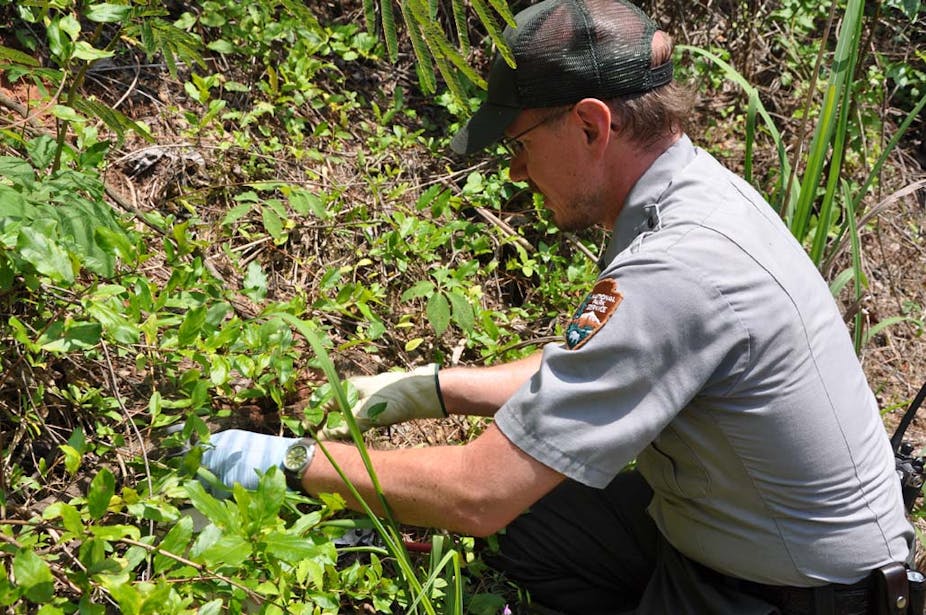Small but mighty, earthworms transform the soil of any ecosystem they inhabit. In farm fields, we appreciate the way they recycle nutrients and aerate soil. But in forests, earthworms’ services can be less welcome.
Glaciers removed native earthworms from northeastern North America and the Great Lakes region 12,000 years ago, so the forests that now stand in these regions developed largely without earthworms. Native earthworms have only slowly returned north. Most earthworms living in these forests today were introduced from Europe and Asia – likely arriving via ships’ ballast and soils of imported plants – and they continue to spread from activities that transport soil or by dumping fishing bait.
Introduced earthworms are considered invasive in forest ecosystems because they have many negative impacts, from eliminating the forest floor layer to reducing the diversity of understory plants. In particular, species like nightcrawlers that carry surface leaf litter into deep, vertical burrows have dramatic effects on forest floors. Recently, researchers have proposed an even more nefarious role for earthworms, which interests me as a plant ecologist: They may be hidden drivers of plant invasions.

Can earthworms pave the way for invasive plants?
My students and I recently collected earthworms from a local park in northeast Ohio. The technique is delightfully simple: We mix ground yellow mustard with water and pour it on the soil. Earthworms wriggle to the surface, annoyed but lively.
We found hundreds of earthworms in a few square meters, but not a single native one. Here, near the southern boundary of glaciation, we do occasionally find native earthworms, though in much lower numbers than European species. In more northern regions like New England and the northern parts of Minnesota, Wisconsin, Michigan and New York, all earthworms present belong to introduced species.
Increasingly, ecologists have noticed that invasive plants tend to dominate areas where invasive earthworms are also abundant. In a recent synthesis of 645 observations across the United States and Canada, researchers found that the cover of nonnative plant species in forests increased with increasing mass of earthworms in the soil. This evidence supports a positive association between invasive plants and earthworms in eastern North American forests.
But we know less about what may cause this apparent correlation. Invasive plants and earthworms may simply thrive in the same environmental conditions. Both often show up in forests that humans have disturbed or previously used for agriculture, which seems likely to explain at least part of the association.
Could earthworms also create pathways for invasive plants? Or, conversely, could invasive plants lead the way for earthworms? Either pattern would be cause for concern, because synergistic interactions could lead to an “invasional meltdown,” in which multiple invasive species together cause greater effects and faster changes than the sum of independent invasions.

So far, evidence suggests that earthworms can indeed facilitate plant invasions. In experiments where ecologists created forest-floor habitats with and without earthworms and added seeds of invasive plants, the resulting mass of invasive plants often, but not always, increased in the presence of earthworms. For example, in a greenhouse experiment using plant communities native to Minnesota forests, earthworms promoted germination and establishment of the invasive shrub buckthorn.
Eating seeds and changing soil chemistry
How does this process work? Earthworms affect competition among plants both indirectly, by modifying habitat, and directly, by selectively eating roots, seeds and seedlings. The changes they make in forest habitats could favor invasive plants in several ways.
Physically disturbing the forest floor could allow for aggressive species to establish. Earthworms can increase soil pH and mobilize nutrients, potentially favoring invasives, which often capitalize on excess nutrients more effectively than native plants. This effect may also help explain why earthworms tend to promote the growth of grass-like plants, which is good news for invasive grasses like Japanese stiltgrass.
When earthworms invade forests, they also alter the mix of bacteria, fungi and other microbes in the soil and disrupt mycorrhizal relationships between soil fungi and plant roots, which most plants rely on to gather nutrients. For example, garlic mustard, an invasive plant common in eastern North American forests, is unusual in that it does not form mycorrhizal relationships. If earthworms damage the mycorrhizae of surrounding native plants, garlic mustard could gain a relative advantage. This could contribute to the correlation between earthworm and garlic mustard abundance.
Earthworms’ selective eating and dispersing of seeds has the potential to favor invasives as well. They digest most of the seeds they eat, so any species they avoid might benefit. But seeds that pass through the worms’ gut intact could gain from burial in the soil, protecting them from predation and harsh conditions, or end up in nutrient-rich earthworm casts (excrement) or middens (piles of casts around burrow entrances), which are good places to germinate. With their diminutive mouths, most earthworms prefer smaller seeds, so they repress the establishment of smaller-seeded plant species and promote the establishment of larger seeds.
Two-way relationships?
For all the ways in which earthworms may aid invasive plants, the plants may return the favor. For example, many invasives produce the quick-to-decompose leaf litter that earthworms love. When scientists removed invasive shrubs like buckthorn and honeysuckle from oak forests in Wisconsin, earthworm abundance fell dramatically.
This encouraging outcome shows that we need to understand how earthworms interact with specific invasive plants. Identifying and breaking positive feedback loops could help us counter both invasions.

